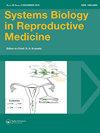COVID CONTINUES, SCIENCE ADVANCES, A NEW YEAR OF SBiRM BEGINS.
IF 2.1
4区 医学
Q3 ANDROLOGY
引用次数: 0
Abstract
Systems Biology in Reproductive Medicine (SBiRM) brings male and female reproductive medicine and sciences together to reflect each partner’s contribution to the birth and health of the child. The work published in SBiRM reflects the synergy that embraces the breadth of research recognizing our long-standing bench to bedside philosophy. We highlight those contributions that emphasize integrating basic, agricultural, and clinical research for public good. Animal studies and model systems offer insights into what would be considered intractable questions when addressed in human systems. The journal continues its upward trajectory, paralleling the growth of our Editorial Board in step with the interests and breadth of developments represented in the field. SBiRM is pleased to welcome two new Editorial Board members, Dr. Samantha B. Schon, Division of Reproductive Endocrinology and Infertility, Department of Obstetrics and Gynecology, University of Michigan, and Dr. Alexander Suvorov, Department of Environmental Health Science, School of Public Health and Health Sciences, University of Massachusetts Amherst. We look forward to including their expertise on the Editorial Board. Two of our Editorial Board members, Drs. Minguez-Alacon and Primig are leaving the Board, and we thank them for their involvement in and support of the journal. We wish both Dr. Minguez-Alacon and Dr. Primig the best in their future endeavors. Last year’s publications were coauthored by several of our Editorial Board members. The first paper of Volume 67 (2021), a review titled ‘COVID-19 and human reproduction: A pandemic that packs a serious punch,’ was initiated and coordinated by Dr. Anifandis with the collaboration of eight additional Board members. Drs. Tempest, Oliva, Simopoulou, Easley, Primig, Turek, Sutovsky, and I were included among the coauthors. The 2021 cover was selected from the paper titled ‘Orchestrating the expression levels of sperm mRNAs reveals CCDC174 as an important determinant of semen quality and bull fertility,’ coauthored by Board member Dr. Selvaraju. Other papers with Board members as coauthors included Dr. Pilsner, ‘Extracellular vesicle cargo of the male reproductive tract and the paternal preconception environment’; Dr. Siristatidis, ‘Investigating the impact of different strategies for endometrial preparation in frozen cycles considering normal responders undergoing IVF/ICSI cycles: a multicenter retrospective cohort study’; Drs. Suvorov, Pilsner, former Board member Hauser, and I, ‘Optimization of small RNA extraction and comparative study of NGS library preparation from low count sperm samples’; Drs. Anifandis and Simopoulou ‘SARS-CoV-2 vs. human gametes, embryos and cryopreservation’; Drs. Oliva and former Board member Miller, ‘Semen sampling as a simple, non-invasive surrogate for prostate health screening’; and Dr. Anifandis, ‘Effect of adiponectin on estradiol and progesterone secretion from human luteinized granulosa cells in vitro.’ The first issue of 2022 begins with a Review and Hypothesis, ‘The balance between cell survival and death in the placenta: Do neurotrophins have a role?’ by Prachi Pathare-Ingawale and Preeti Chavan-Gautam. This paper reviews the expression and function of placental neurotrophins and their receptors and discusses their possible role in development and apopotosis. This is followed by a Review, ‘Mucosal biomar-kers for endo metrial receptivity: A promising yet underexplored aspect of reproductive medicine’ by Mark Jain, Larisa Samokhodskaya, Elena Mladova, and Olga Panina. The authors provide a pathway for future studies by identifying promising analytical targets of endometrial receptivity that include several oxidative stress biomarkers. The next paper is a Clinical: Research Communication, ‘Sperm motility in astheno-zoospermic semen samples can be improved by incu-bation in a continuous single culture medium (CSCM®)’ by Caroline Ranea, Juliana Pariz, Joel Drevet, and Jorge Hallak. The authors provide a simple, reproducible protocol to assess motility in asthenozoospermic semen specimens. Three Research Communications follow beginning with, ‘Cumulus cell acetyl-CoA metabolism from acetate is associated with maternal age but only partially with oocyte maturity’ by Sharon Anderson, Peining Xu, Alexander J Frey, Jason R Goodspeed, Mary T Doan, John J Orris, Nicolle Clements, Michael J Glassner, and Nathaniel W Snyder, emphasizing oocyte function and age-related fertility should be considered when examining cumulus cell metabolism of non-glucose substrates. SYSTEMS BIOLOGY IN REPRODUCTIVE MEDICINE 2022, VOL. 68, NO. 1, 1–2 https://doi.org/10.1080/19396368.2022.2017733新冠病毒在继续,科学在进步,新的一年开始了。
本文章由计算机程序翻译,如有差异,请以英文原文为准。
求助全文
约1分钟内获得全文
求助全文
来源期刊
CiteScore
4.30
自引率
4.20%
发文量
27
审稿时长
>12 weeks
期刊介绍:
Systems Biology in Reproductive Medicine, SBiRM, publishes Research Articles, Communications, Applications Notes that include protocols a Clinical Corner that includes case reports, Review Articles and Hypotheses and Letters to the Editor on human and animal reproduction. The journal will highlight the use of systems approaches including genomic, cellular, proteomic, metabolomic, bioinformatic, molecular, and biochemical, to address fundamental questions in reproductive biology, reproductive medicine, and translational research. The journal publishes research involving human and animal gametes, stem cells, developmental biology and toxicology, and clinical care in reproductive medicine. Specific areas of interest to the journal include: male factor infertility and germ cell biology, reproductive technologies (gamete micro-manipulation and cryopreservation, in vitro fertilization/embryo transfer (IVF/ET) and contraception. Research that is directed towards developing new or enhanced technologies for clinical medicine or scientific research in reproduction is of significant interest to the journal.

 求助内容:
求助内容: 应助结果提醒方式:
应助结果提醒方式:


